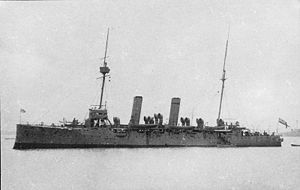HMS Talbot (1895)
 Talbot at anchor, c. 1904
| |
| History | |
|---|---|
| Name | HMS Talbot |
| Builder | Devonport Dockyard |
| Laid down | 5 March 1894 |
| Launched | 25 April 1895 |
| Completed | 15 September 1896 |
| Out of service | 1919 |
| Fate | Sold for scrap, 6 December 1921 |
| General characteristics | |
| Class and type | Eclipse-class protected cruiser |
| Displacement | 5,600 long tons (5,690 t) |
| Length | 350 ft (106.7 m) |
| Beam | 53 ft 6 in (16.3 m) |
| Draught | 20 ft 6 in (6.25 m) |
| Installed power |
|
| Propulsion | 2 shafts, 2 Inverted triple-expansion steam engines |
| Speed | 18.5 knots (34.3 km/h; 21.3 mph) |
| Complement | 450 |
| Armament |
|
| Armour |
|
HMS Talbot was an Eclipse-class protected cruiser built for the Royal Navy in the mid-1890s.
Early career
HMS Talbot was laid down 5 March 1894 and launched 25 April 1895. She commissioned on 15 September 1896 for service on the North America and West Indies Station, but was back in the United Kingdom a couple of years later.
In 1899 she brought back, from the United States, the body of Lord Herschell to London.[1]
In April 1901 she was commissioned at
She was present at Chemulpo Bay in 1904, during the historical naval battle between two Russian ships, the cruiser Varyag and the gunboat Korietz against a fleet of the Imperial Japanese Navy. Future Arctic explorers and members of Robert Falcon Scott's ill-fated Terra Nova Expedition Patrick Keohane and Edward Evans served aboard her.
First World War

During the
In May 1916 Talbot was operating off the East African coast as part of the Cape Command. In January 1917 she was at Kiswere (Tanzania), when the second period of German commerce raids began and in 1918 she was off the Cape of Good Hope.

Fate
She was laid up at Haulbowline, Cork Harbour from 1919-1921. She was sold for scrap on 6 December 1921.
Footnotes
- ^ "At the Close of the Day, HMS Talbot bringing Home the Body of the late Lord Herschell". Look and Learn. The Illustrated London News, 18 March 1899. Retrieved 28 April 2021.
Source: At the Close of the Day, HMS "Talbot" bringing Home the Body of the late Lord Herschell. Illustration for The Illustrated London News, 18 March 1899.
- ^ "Naval & Military intelligence". The Times. No. 36426. London. 11 April 1901. p. 5.
- ^ "Naval & Military intelligence". The Times. No. 36636. London. 12 December 1901. p. 10.
- ^ "Naval & Military intelligence". The Times. No. 36800. London. 21 June 1902. p. 12.
- ^ "Naval & Military intelligence". The Times. No. 36820. London. 15 July 1902. p. 11.
References
- Chesneau, Roger; Kolesnik, Eugene M., eds. (1979). Conway's All the World's Fighting Ships 1860–1905. Greenwich, UK: Conway Maritime Press. ISBN 0-8317-0302-4.
- Gardiner, Robert; Gray, Randal, eds. (1985). Conway's All the World's Fighting Ships 1906–1921. Annapolis, Maryland: Naval Institute Press. ISBN 0-85177-245-5.
- McBride, Keith (2012). "The Cruiser Family Talbot". In John Jordan (ed.). Warship 2012. London: Conway. pp. 136–41. ISBN 978-1-84486-156-9.
